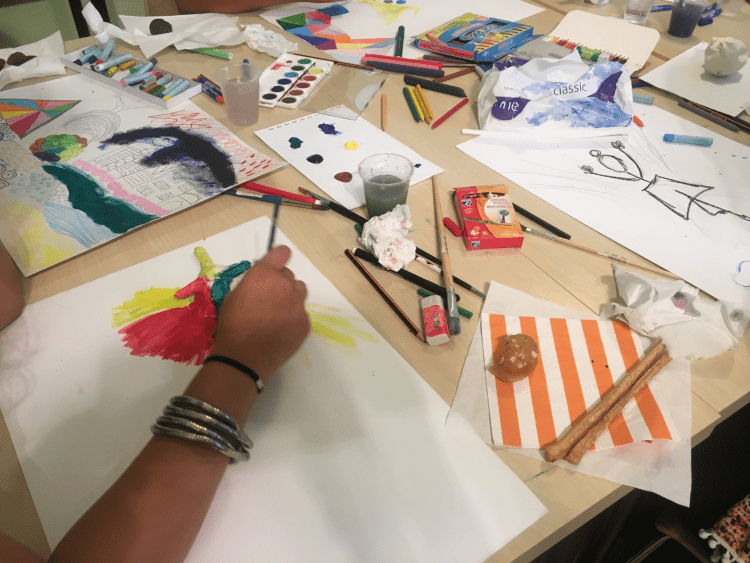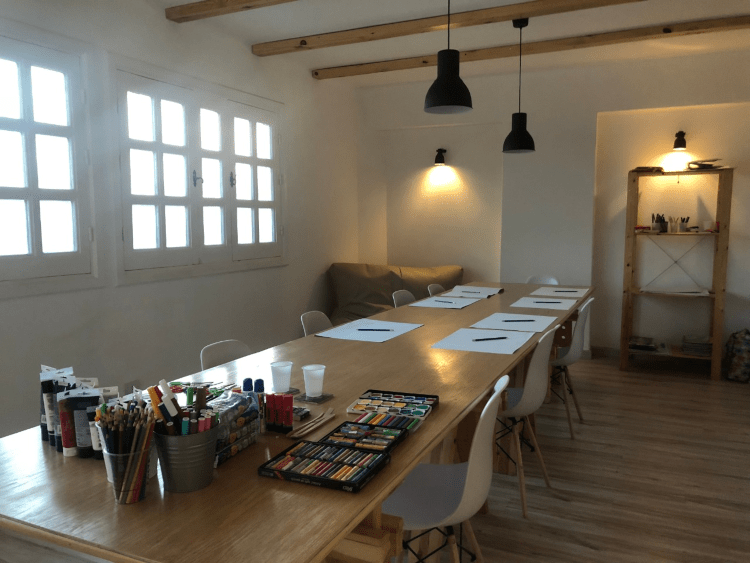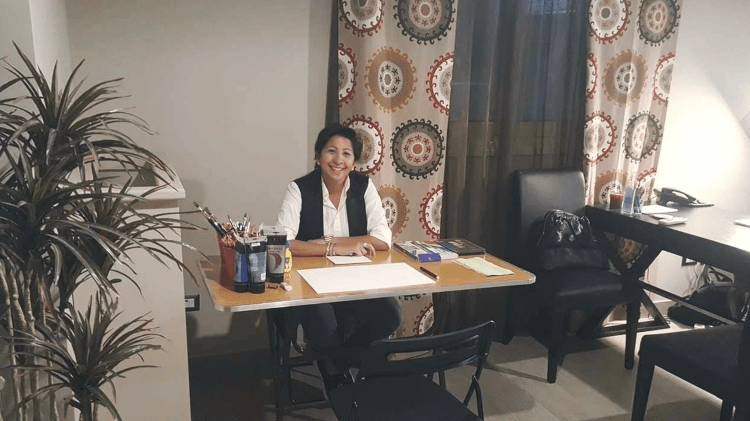As we go on about life, we experience different emotions, go through “moods”, and it is all flowing through our thoughts and bodies. Naturally, we experience unpleasant emotions. One thing we have to keep in mind is that our mental health is extremely vital to us.
Therapy has been on the rise in Egypt, and it is becoming “less taboo,” as some have put it. This is encouraging news, especially as we become increasingly conscious of the value of treatment and mental health. However, as medicine advances, therapy advances as well.
There are different forms of therapy, and one type that has been gaining much traction is art therapy. Historically, healing through art has always been a part of the human experience; however, recently, it has evolved as a new type of mental therapy for a wide range of mental illnesses. Art therapy has been getting increasingly popular, yet it has a long road ahead of it.
To learn more about art therapy, we thought of none other than Egypt’s first trained art therapist Ms. Carol Hammal who is credited with establishing the field of art therapy in Egypt. Here is how our interview with her went.

Ms. Hammal with second lady Karen Pence during her state visit to Egypt as part of her global art therapy campaign.
What Is Art Therapy?
Art therapy is a mental health profession that uses the creative process of art-making such as drawing, painting or sculpting, as means of expressing what we are unable to verbalize or put into words.
It allows the unconscious thoughts and feelings to naturally emerge and get externalized onto the paper/canvas. Through the verbal interactions that occur between the art therapist and the client, we get to examine this visual information and communicate it; this process helps us ease our anxiety and get insight into what may be inside us.

Ms. Hammal with second lady Karen Pence during her state visit to Egypt as part of her global art therapy campaign.
What got you into this esteemed profession and what makes it so special for you?
I’m an amateur musician and I also studied visual art as an undergraduate, so as an artist, I am psychologically connected to the work that I do. I’ve always thought of art as an extension of myself. Making art or music always had a positive impact on my mood and always allowed me to express what I internally felt.
During my time at the American University in Cairo (AUC), I once sketched an impromptu drawing, mostly out of scribbles, during a very stressful period. I had just scribbled for 5 minutes on the pad when I was surprised to see those scribbles transform into an abstract face with incredibly expressive eyes; I had no aim of creating anything specific. I had a feeling and wanted to express it on paper, and I got immediate relief as a result. So I took this piece to my professor and explained what happened then asked what this was. The process I felt was foreign to me as I usually almost always create art with some form of visual intention. My professor’s answer simply was: “Oh! This is almost like art therapy!”. Immediately, I went to the library to read about it, and I discovered that there’s an entire profession that focuses on the link between art and psychology. Since that moment, my life was never been the same. I knew deep down that I wanted to do something big with this.
Of course, I never would have imagined back then that I would end up becoming a trained art therapist, but I just knew that this was the start of a long meaningful journey, and what a fruitful journey it has been!

(Photo taken with consent).
Why is art therapy any different from regular therapy sessions?
Art therapy has a very similar structure to verbal psychotherapy sessions. We not only make art but also talk and converse in a similar way as counseling therapists do. In addition to the talking, there’s time dedicated to art-making based on the therapeutic goals that we need to reach throughout our journey in therapy.
The art-making portion of the session allows the clients’ defenses to break down; therefore, they are a lot more open and ready to share, especially when resistant at first. Also, the art-making process allows the unconscious to become conscious, and with the help of the art therapist, the client can further understand what is being externalized through the art and why. It also allows them to be more engaged in their therapeutic process.

Who can benefit from art therapy sessions?
Art therapy is for everyone, but art therapists usually specialize in a certain population. So for myself, as an example, I work with adults, and I specialize in Medical Art Therapy, which is mainly working with clients suffering from chronic, degenerative, or terminal medical conditions. I primarily work on the psychological aspect related to the medical illness while doing a lot of psycho-education about the condition itself and its management. I also have a unique specialty, and that is Digital Art Therapy, wherein clients use digital art tools instead of traditional art materials.
With that said, I practice with all adults according to their needs because anyone can benefit from art therapy. You don’t need to have a specific diagnosis to seek art therapy. Sometimes all you need is some insight and self-exploration, and art therapy can help a lot with that process.
Any specific mental illness that art therapy is best suited for?
Again, art therapy is for everyone; it just depends on the art therapist’s area of expertise. Some work with psychiatric conditions such as depression, bipolar disorder, or schizophrenia. Some work with addiction- I offer art therapy groups in an inpatient addiction unit. Others work with children in schools or with children dealing with learning difficulties such as autism.
Art therapy is tailored according to the client’s needs and the art therapist’s expertise.
What kinds of feelings do you normally see during the session, anger, stress, etc?
Of course, every client is different. Some may hesitate longer to draw or paint what they feel or what they want to convey. It is the art therapist’s role here to help the client express what they need more easily and smoothly. Sometimes alternating the art material or briefly conversing about the topic itself before visually expressing it may help the client break through their initial defenses.
Artwork made by the client may express all sorts of feelings, positive and negative ones. And, sometimes the use of a specific art material may help the client express those feelings more easily. For example, the use of watercolors or paint may allow clients to express feelings more fluidly because such material is known to externalize emotions in a much easier way than other art materials such as pencils or markers.

(Photo taken with consent)
How long does the session usually last?
This is typical of all psychotherapy sessions; each individual session is of one “therapy hour”, which usually consists of 50 minutes.
With groups though, they can sometimes vary between 70-120 minutes.
Do you ask them to draw something specific or do they have the complete freedom to draw whatever comes to their minds?
Usually, I ask for a semi-specific topic; the topic is usually relevant and related to what therapeutic goal I’m trying to achieve in a session.
However, the free nature of art-making is equally powerful and useful, so I may sometimes let the client freely express what is on their mind.
Also, in open-studio art therapy groups, which rely heavily on the art-making process and less on the clinical aspect of art therapy, clients are highly encouraged to do their own artwork freely, without prompts or directives.
Does the client need to have an artistic background to convey their feelings?
Not at all. The art made in art therapy sessions is intended as means of expression and is used within the therapeutic context, not the aesthetic one.
Art skills are not required in order for a client to participate in art therapy sessions.
How about art therapists, do they need to have a deep artistic background as well?
Yes indeed, art therapists need to have a prior academic background in both art and psychology before applying to a master’s degree in art therapy. Some master’s programs require pre-requisites while some offer those requirements to be taken during the master’s phase itself.
Art therapists need to have a full background in the use of multiple art media, and in specific, areas of psychology such as developmental psychology and psychopathology.
How many sessions usually would the client need and when would you decide that they will need a break from the sessions?
There is no specific number of sessions. Every client is different, but what really helps is having the sessions on a regular basis which helps us to reach better outcomes. Some clients come for just 12-20 sessions. Some come for a year or two. It truly depends on the therapeutic goals that are set by the art therapist.
As for ending sessions, usually, it is agreed between both client and therapist once the therapy goals have been achieved or other reasons for stopping therapy occur. Typically, the art therapist schedules what is called a “termination session” where the therapist reviews the therapeutic journey with the client and allows for a full closure.
What are the different techniques of art therapy and how would you change the approach depending on the mental illness that the client is suffering from?
Absolutely. Every case is different and part of an art therapist’s role is to know what art material to administer to which client, and which directives to use based on the client they’re working with. This is a crucial part that makes art therapy graduate training necessary because oftentimes, untrained art therapists will evoke and even provoke further damage in a client if they used the inappropriate approach. It takes years of training to master the techniques used based on what is needed throughout the therapeutic journey with a client.
And do keep in mind that certified art therapists are trained to diagnose and treat mental health illness as primary therapists; which means a client can refer to an art therapist as their primary treating specialist. Art therapists also often work as part of a multi-disciplinary treatment team in inpatient or outpatient settings along with counseling psychologists, psychiatrists and social workers. And at any point, if an art therapist sees that the client may need further interventions such as the help of a psychiatrist to prescribe medications, they will easily refer them to one while working in parallel with the client.
Do you think there is a stigma about it and that’s why art therapy is not yet known or popular?
On the contrary, I believe that the stigma directed towards therapy in Egypt has driven art therapy forward. That may surprise you, but in fact, art therapy is often offered as a powerful therapeutic option for the ones who do not want to speak much, or who have a general resistance towards traditional psychotherapy. The act of art-making makes people curious enough to try art therapy, and through this attempt, they discover that there is so much to be done in art therapy sessions to bolster their personal development and improve their mental health.
Art therapy in Egypt has been steadily growing, albeit slowly. In fact, I now head a Creative Arts Therapy Department in an established online therapy platform in Egypt. This was never possible before because, for many years, I was simply the only certified art therapist practicing in Egypt. And there was no point in establishing a department consisting of one person. But today, the department consists of three art therapists including myself and a drama therapist. All Egyptian. We are steadily growing in number.
We may be growing slower than expected and that is mainly because we still need an academic master’s degree to locally train art therapists. An undergraduate diploma or bachelor’s degree is not enough to qualify an art therapist. So until we have our own master’s program, the number of Egyptian art therapists will be limited, which is quite sad because so many have approached me over the past 10+ years requesting information about art therapy education in order to get trained.
So I personally took it as my quest to help every Egyptian interested to pursue the field by offering them guidance towards choosing the right school (unfortunately only available abroad) and often offering them supervised internships and training workshops upon their application to a master’s degree in order to prepare them better for this journey. This has been gratefully achieved over the years and we now have a few more Egyptian art therapists who pursued their degree abroad and came back to Egypt to practice. I am also currently supervising an Egyptian student who is finishing up her master’s degree in the US and is fulfilling her internship hours here in Egypt. I can’t wait to see her become yet another Egyptian certified art therapist very soon.
WE SAID THIS: Make sure to also check out….Looking For Online Therapy? There Are BetterHelp Alternatives That Could Help You



